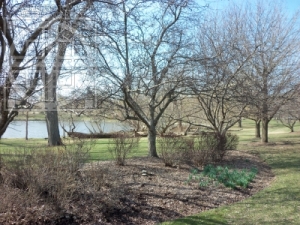
Appearing for the first time ever on our Schaumburg Township history radar is the Blue Hills Country Club. If you look at the 1929 Cook County map above, you will see the Westmoor CC that is now known as the Schaumburg Golf Club and the Meadow Brook CC that was originally built on, what is today, the Village of Schaumburg property on Schaumburg Road. Until now, knowledge of the Blue Hills CC had died along with those who could have told us about it.
In doing a bit of research, the name appeared, ironically enough, in the September 21, 1928 issue of the Daily Herald under a list of upcoming auctions. “Tuesday, October 16, 1928. Fred L. Broker on the old Fasse farm, 2 1/2 miles east of Schaumburg, 1 mile south of Higgins Road, on Medinah Road, at present known as the Blue Hills Country Club.” (They were actually referring to Meacham Road in Schaumburg Township.)

You can see the Herman and Henry Fasse farms on this map on the east side of Meacham Road, though it is Herman’s farm that is directly on Meacham/Medinah Road. Herman (alternatively known as Heinrich) was the father, and Henry or Herman Heinrich was the son. Herman married Bertha Redeker, the daughter of H.C. Redeker, whose farm was directly to the north.
The road that separated the Redeker and the Fasse farms was Old Schaumburg Road which, even today, exists and takes a jog off of the main portion of Schaumburg Road, reconnecting with it further east.

In addition, the District 53 School, which is visible on the 1929 map, was also on the Fasse farm. Because the land for the school had been contributed by the Fasse family, the school was locally known as the Fasse School. The school was just off of Meacham/Medinah Road.
Going back into the Daily Herald a bit earlier, we see a mention in the April 23, 1926 issue that states, “Her. Fasse sold his farm recently to a Chicago party.”
Thanks to Carolyn McClure of the Schaumburg Township Historical Society who passed on an article from the November 27, 1927 issue of the Chicago Sunday Tribune, we know that that group was the Master Masons of 30 N. LaSalle Street, Chicago.
Their plan for the property involved “two courses, one an eighteen hole and the other a nine hole affair.” The unique aspect of the plan was that “each member of the Blue Hills Country Club will designate a boy for membership… these youngsters will elect their own officers and do their own governing, independently of the grownups.”

This 1935 map shows the location of the District 53 school and the various driveways off of both Old Schaumburg Road and Meacham Road.
The Chicago Tribune article states that the club was “on the east side of Medinah Road [formerly called Meacham Road] and is bounded on the north by the Schaumburg Road. Its east boundary if Rohlwing Road. The property is half a mile south of Higgins Road.” So, we had the correct location pegged for the golf course.
The plan also included clubhouses for both the members and the boys. In addition, they were considering an “athletic field with a stadium where all kinds of outdoor sports may be enjoyed and tournaments held by the boy members.”
The main clubhouse “will be of colonial type, designed by Robert M. Hyde, one of the directors of the organization and will be arranged for a wide variety of activities. Mr. Hyde also is preparing plans for the stadium… The golf courses and the grounds will be laid out by James Faulis Jr.”
Work was supposed to begin in the spring of 1928 “with the expectation of having things ready for golfing by fall, possibly a few holes in the late summer.”
Apparently these plans fell through as Fred L. Broker inevitably wound up the owner of the property in late 1928, per the auction notice in the Daily Herald.
We know that Fred Broker married his first wife Amanda in 1909. The couple then had two children before Amanda, unfortunately, died at a young age in 1920. Fred later married Emily Becker in 1924 who was born in Schaumburg Township. They then purchased the former Fasse property from the Master Masons in 1928.
The country club plans lasted a mere two years–at the most. As a follow up to the 1928 auction, a March 1, 1929 issue of the Daily Herald, stated that “Mr. Fred Broker is leaving this place and moving to West Chicago.” Three months later, a mention in the June 28, 1929 issue of the Daily Herald states that “Mr. and Mrs. Fred Broker have left for their home in Kansas.” They were eventually buried there in Aliceville, KS.

We also know that the country club was never developed because we have this photo of the Herman and Bertha (Redeker) Fasse farmhouse that was part of the farm eventually purchased by L.D. and Dorothy Kern in 1935. They had the house torn down and remodeled the barn as their new home with the help of architect Paul Schweikher.
There is a bit of roll to the land in this area and the local branch of Salt Creek meanders through on its way to Busse Woods. It would have made a bucolic golf course and, ironically enough, this area contains the Fox Run Driving Range.
The Roaring Twenties was a busy time in the Chicago area golf world and Schaumburg Township was no exception. Fortuitously, the Blue Hills Country Club managed to be on the local radar just long enough to appear on the Cook County Highway map of 1929.
Jane Rozek
Local History Librarian
Schaumburg Township District Library
jrozek@stdl.org







